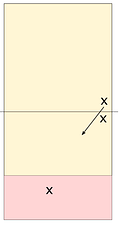Centerfield
This week is Beach Week. Typically I dedicate the first 3 weeks of each month to indoor volleyball and the fourth to beach, but I’ve rearranged the schedule slightly to synch up with the NCAA Beach Volleyball National Championship, which takes place this week. So this is April’s Beach Week. And I’ll pull forward the May Beach Week to next week. Two Beach Weeks in a row. Coaches who only care about indoor: see ya in a couple weeks!
In Monday’s article, I talked about ways to win with a Terminal Serving Weakness profile. In that article, I broke down 4 different ways that profile might manifest, and how the training implications are a little different for each way. In particular:
If You Miss Too Many Serves
The good part about missing a lot of serves: it takes pressure off your block! But seriously, if I’m serving tough and aggressively then (a) I’m missing some serves so I literally have fewer defensive opportunities and (b) I’m probably serving tough enough to knock the other team off the net a fair bit.
I probably don’t need to be the world’s best blocking team, but I do need to be really good in Transition. I’m knocking them off the net and I should get some chances to dig. But if I’m already giving them free sideouts by missing a bunch of serves AND I can’t score in Transition? My overall point-scoring is going to be too low to win tough matches. If I have a team that I know serves tough, I want to make sure my blockers are good pullers and we can take advantage of opportunities to pull and kill the ball in Transition.
This section highlights a team profile that needs to be good in Transition to be successful. I mentioned a drill called Beat The Puller which I like as a block/defense drill:
Another drill along the same lines is one I call Centerfield.
Setup
This one is simple. Instead of drawing a line in the sand that splits the court vertically, you’ll draw a line that splits the court horizontally, parallel to the net. I find that somewhere between “back half” and “back third” of the court is about right. More on this shortly.
The offensive team gets a bowl or easy serve entry and the defensive team gets a chance to set up for a defensive stop. No on-2 allowed, at least to start. The offensive team must attack into the red zone to get a chance to score and the defensive team has a chance to dig and attack in Transition.
You can do this for some reps and just have the defender try to dig the ball and then send it back over the net. This can be valuable for juniors defenders who are trying to learn how to play with a blocker and defender rather than just the 2-back defense that many juniors kids start out with. But in short time, I like to progress to playing the rally out, because digging doesn’t mean much without transition attacking. So the rally starts with a centerfield play, and then from there anything goes.
Making It Work
Similar to Beat The Puller, this is a simple contstraints concept that you need to tweak to make sure it fits the players that are playing this drill. Lower-level teams need a bit bigger of an area to attack into, or otherwise you spend the whole time coaching up the hitting errors rather than working on defense.
You also want to decide what you want the blocker to do. Again, for lower-level teams, the blocker can do almost nothing and just let the defender read and dig. For higher-level teams, a good way to do it is to start with the blocker just taking line and letting the hitter hit inside or shoot over top. You can also just keep the blocker down, but if so, you want either to put them in a less-than-great pass or just tell the setter to keep the ball off the net. If you have a high level team with the setter keeping the ball on the net and the block staying down, the defender will be in a tough spot.
What It Looks Like
The above clips show two good examples of centerfield defense. The defenders are setting up about a step to the crosscourt and reading from there. This can’t be the only defense you play, but this is a foundational element to teach defenders. I like the setup, the balanced defensive posture, and the simple eyework.



